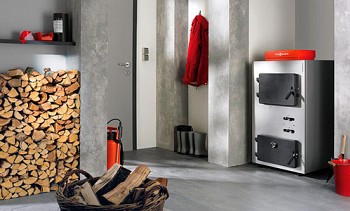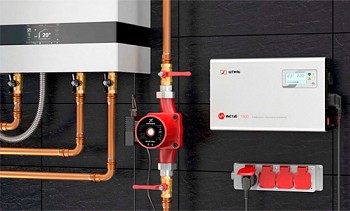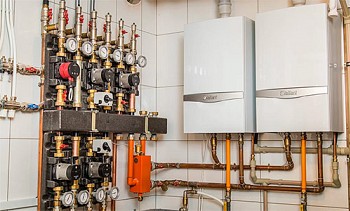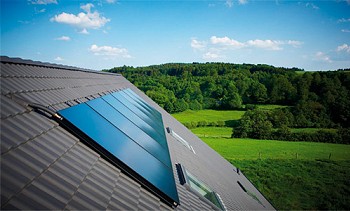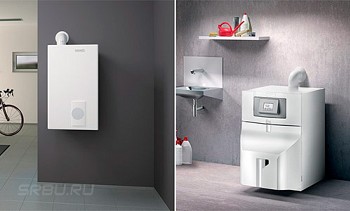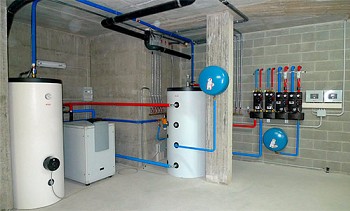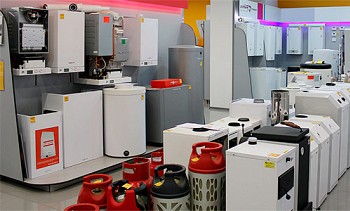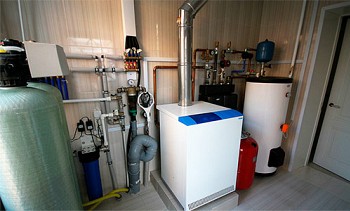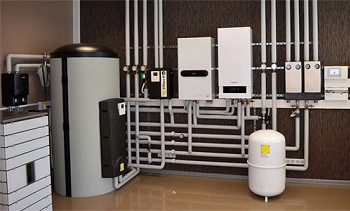This article will help you figure out how to choose a voltage stabilizer for a gas boiler, among the many types and various characteristics, which will protect the electronics of expensive gas equipment from breakdowns and contribute to trouble-free operation.
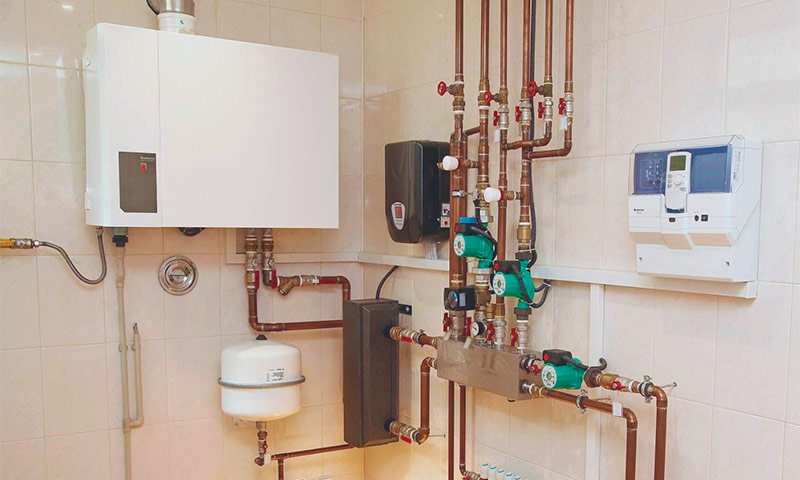
Content:
Why voltage stabilization is important for a gas boiler
Modern gas boilers represent a whole range of equipment in one building, which is designed not only to heat the coolant, but also closely monitor the quality of work and safety. For this, electronic units with microprocessors and LCD displays are introduced into the boilers. Home appliances are equipped with sensors, valves, fans and pumps. Electronics equipment controls the operation of all units and makes timely adjustments.
Among these systems and functions, the following are possible:
- Automatic shutdown of the boiler in case of draft drop, difficulty in removing combustion products, decreasing gas pressure in the line, flame attenuation, congestion or breakdown in the heating circuit. It also works in other emergency situations.
- Modulation of the flame by automation with setting the number of burners involved and the height of the fire in each of them.
- Prevent freezing of the system during prolonged shutdown. Independent short-term start-up to run the carrier, open the valves, pump the pump, preventing damage to the internal elements.
- Smooth ignition and a decrease in flame intensity when approaching the set temperature indicator, which ensures sparing operation and reduces the number of restarts.
- Maintenance of different temperatures in several circuits with the preservation of the entered settings. Programming can be associated with the time of day, days of the week.
- Continuation of the circulation of the pump after turning off the flame, ensuring even heating in all parts of the circuit.
- Analysis of external weather data by the artificial intelligence of a gas boiler and selection of an appropriate operating mode to create the most comfortable microclimate. The function helps to save resources by optimizing the desired interaction of blocks and nodes.

To understand whether a voltage stabilizer is needed for a gas boiler, it is worth considering what is happening in its work in practice. Gas boilers for domestic use are designed to be powered from a 220-230 V network with a small error of + -10-15%. With a voltage drop of 20 V. the boiler will continue to fully function. But the current drop in the network can be much greater, up to 140-180 V. This is especially observed in the private sector, where weak lines are deliberately stretched. In this situation, the equipment will work unstably, it is possible to disable some of the above functions or just stop until the full power is restored.
In more serious cases, not a drop, but a power surge. The current in the network can shortly reach 250-300 V, which will lead to damage to the circuit board of the program unit, burnout of electronic circuits or complete failure of the printed circuit boards. Then it will require expensive repairs or even replacement of the boiler.
A drop in voltage or its surges is quite possible due to the following factors:
- increasing load on the line due to an increase in the number of consuming devices in the population;
- interference with an unqualified person in a panel entrance or junction box on the street, leading to a shorted wire;
- snapping live parts of the line on top of each other as a result of weather disasters (ice freezing on wires, strong wind).
Given these factors, you should definitely get a current stabilizer for a gas boiler, which will ensure its long-term operation. But what are the stabilizers and how to choose the right one?
Which voltage regulator is best for a gas boiler
All types of voltage stabilizers are designed to implement two tasks: when falling or surges, bring the output current to a value as close to 220 V as possible, and break the circuit if the indicator is too large, and the stabilizer does not allow it to normalize. This contributes to the correct operation of the heating equipment and protects sensitive electronic components from overload. Structurally, stabilizers are divided into three types, each of which has its own advantages and disadvantages. Having examined and compared them, it will be possible to more accurately determine what kind of voltage stabilizer is needed for a gas boiler in a specific situation.
Electromechanical Stabilizers
Their operating principle is built on the circular windings of the transformer along which the carbon brushes move. The rotation is due to the servo drive. Depending on the input voltage, the device moves the brushes to a certain position, providing the desired outgoing current.


+ Benefits of Electromechanical Stabilizers
- high accuracy + -3%;
- low cost;
- wide range of adjustments;
- able to tolerate significant overload;
- small body sizes.

- Disadvantages of Electromechanical Stabilizers
- low speed (response time of about 2 s, which is a lot for sensitive electronics);
- in case of a sudden power surge, it may react incorrectly (excessively reduce or overestimate the output value);
- it does not work well at low temperatures (if you take the unit out of the boiler room)
- the design of the slider and the servo drive is completely mechanical and short-lived due to friction and wear of the brushes;
- noisy work;
- may spark on the contacts (between the winding and the brushes), which is unacceptable when used with gas equipment and requires remote installation.
Such stabilizers are suitable for gas boilers, but safety must be taken into account, which includes arranging a heated place for installation and remoteness from the heater itself.
Relay stabilizers
This type of stabilizer is more modern and widespread. Five to twelve relays are connected to the transformer winding, each of which is enclosed in a sealed enclosure. Depending on the change in the input voltage, the current is launched through one of them along the circuit as close as possible to 220 V, which ensures its alignment in the direction of the norm. The larger the number of relays, the more accurate the setting of the value. The design lacks mechanical components.


+ Benefits of Relay Stabilizers
- quick response to differences;
- wide range of input voltage;
- tolerates power overloads well;
- able to work at subzero temperatures;
- no constant maintenance and monitoring is required;
- long service life due to the absence of mechanically moving parts;
- relatively affordable cost.

- Disadvantages of relay stabilizers
- step adjustment with sine wave distortion (the smaller the number of relays, the wider the step, which affects accuracy);
- output voltage error up to 8%;
- noisy work.
Given the price / quality ratio, relay stabilizers are the most common equipment used with gas boilers.
Electronic stabilizers
Electronic stabilizers send current through various circuits of the transformer winding, but they do this not with the help of relays, but thanks to electronic keys - triacs or thyristors.The former are capable of passing current in two directions, and the latter in only one. Such semiconductor elements provide compact equipment dimensions and high efficiency.


+ The advantages of electronic stabilizers
- durability;
- stabilization accuracy 3-5%;
- completely silent;
- unpretentious to operating conditions;
- do not require regular maintenance;
- resistant to freezing temperatures;
- wide range of input values.

- The disadvantages of electronic stabilizers
- sensitivity to overload and interference;
- high price.
Electronic stabilizers can be called the most advanced and versatile equipment for gas boilers. An obstacle to their use can only be a high cost.
What characteristics of the stabilizer must be considered
To understand how to choose a voltage stabilizer for a gas boiler, you need to understand its key parameters and their effect on the operation of the heater. This will help you choose the device that is most suitable for specific operating conditions.
Phase
Most apartment buildings and private houses are connected to a single-phase 220 V network with a frequency of 50 Hz. For the use of voltage stabilizers in them, it is advisable to buy single-phase models. There are houses with three-phase input, but each line is divided and gives 220 V. This contributes to a more even load distribution and allows the use of the same single-phase stabilizers.
For enterprises and productions where large gas boilers with high power are installed, three-phase stabilizers of 380 V are required. The second option may be to install single-phase equipment, one for each phase, which in total will cost less, but will take longer to connect.
Input range and output voltage accuracy
Voltage stabilizers for gas boilers must ensure that the current from the network reaches the optimum 220 V. Depending on the scale of the voltage drop, stabilizers with a different input current range are also produced. To find out what parameters to look for the device, you need to conduct a small study.
To do this, you need a voltmeter (pointer or digital multi-tester). The electronic device must be set to an alternating current with an upper limit of more than 500 V. Measurement should be carried out at different times of the day to see how the indicators change depending on the load on the network. It is optimal to observe during the week and measure volts at: 6:00, 9:00, 12:00, 15:00, 18:00, 21:00, 24:00 hours. It’s good to have a notebook to record the data. At the end of the experiment, you can add 10-15 V in each direction to create a small supply.

If testing showed the limits of 180-240 V, then it is with such data that you should look for a voltage stabilizer. Sometimes, outside the city, the network can have drops from 140 to 270 V, which will already require a different model.
The output voltage of the stabilizer should match the performance of the gas boiler. In most cases, this is 220 V + -10%. To avoid disconnection due to lack of power, it is better to choose devices with an accuracy of the output voltage of + -5%. Then it will completely fit into the data required by the manufacturer and will contribute to smooth operation.
Power
One of the most important criteria for choosing a voltage stabilizer for a gas boiler is power. First you need to find out what indicator is registered in the equipment passport. Two values are indicated for boilers: maximum usable heat output (varies from 6000 to 24000 kW) and power consumption (100-200 W or 0.1-0.2 kW). But during the start-up of the boiler, this value can increase by several seconds, so the stabilizer should exceed the data of the boiler. How much? This will become clear after we find out the other components of the calculation.
The second component is VA. These are volt-amperes, which indicate the power of stabilizers.They differ from kW (kilowatts) or W (watts) in that they represent full power, and the latter only useful. As a result, a device with a capacity of 500 VA will have an indicator of 350 watts.
The power of the stabilizer should cover not only the consumption of the boiler, but also related equipment installed inside or in parallel. It can be a circulation pump, which has its own power indicator.

In order for the voltage regulator to fully correspond to the boiler and the pump, its indicator must take into account the increasing starting currents and have a margin of 30% from the maximum power of the sum of all devices.
Now all this can be fixed by the formula:(boiler power W + pump power W * 3) * 1.3 = power of the stabilizer VA.
For example: a boiler - 150 watts, and a pump - 70 watts. We get: (150 W + 70 W * 3) * 1.3 = 468 VA.
But it is important to consider the voltage drop. If the input current drops, then the stabilizer's ability to increase it also decreases. For example, if there is 170 V. in the outlet, the stabilizer's efficiency will decrease by 80% of the rated power, and at 130 V. it will only work on 50% of the stated indicator. Therefore, the passport power of the stabilizer must be multiplied by a percentage drop and divided by 100.
Calculate:if the network has 170 V, which is 80%, then with a stabilization apparatus of 500 VA it will work as 400 VA. For the boiler 150 W indicated above in the example and the pump 70 W, taking into account the drawdown of 170 V, you need to look for a stabilizer for 600 VA.
Voltage stabilization performance
This parameter is indicated by two units:
- reaction rate - measured in volts per second (V / s) and reports the period spent on restoring the normal output voltage with significant input fluctuations;
- response time - is indicated by milliseconds, which go to the response of the device to change the network signal.
The higher the speed and the response time, the better the gas boiler is protected during jumps, both in one direction and in the other. The highest quality voltage stabilizers have a first rate of 100 V / s and higher. This allows protective equipment to respond almost instantly. Data of 10-20 V / s indicate a certain delay sufficient for short-term incorrect operation of the boiler.
Response time is considered good from 5 ms or less. 10 ms will be acceptable, and 20 ms will be satisfactory. Larger values already imply some risk. In inverter devices, double current conversion is involved, so they do not have a speed parameter.
Output voltage shape
Alternating current is indicated by a wavy line due to the changing frequency. On a scale, it has the shape of a sine wave. In order for the gas boiler to work stably and correctly, the voltage must be as close as possible to the ideal sinusoid. A clean output will not create errors or failures in the electronics.
Availability of protection and restart function
When choosing a voltage stabilizer for a gas boiler, pay attention to the protection options. In very cheap devices, they may not be, which is fraught with failure of the stabilizer itself.
1. An important function is to turn off the device during overload. This happens when it is operating at its full capacity due to a too low input voltage. So that the turns of the transformer or circuit board do not burn out, the device switches itself off.
2. The same process occurs in case of too high surges, accepting which the stabilizer is not able to lower to outgoing 220 V. In order not to harm the gas boiler, the current source is turned off.
3. Depending on the installation location, loads and operating area, the stabilizing device may also experience temperature effects. It is good if, with significant overheating, he will be able to interrupt the line himself before cooling.
4. If you have protection functions, the restart feature will also come in handy, eliminating various inconveniences.For example, when there was a significant voltage drop, the stabilizer turned off, which triggered a gas boiler shutdown. The owners at this time was at work. In the off state, the device continues to monitor network parameters, and when they normalize to values that the device can cope with within its capabilities, the power is restored.
The boiler, having received the connection, starts up, and the owners return to the heated housing. Otherwise, when there is no restart function, by their arrival the whole house has cooled down, although the voltage has long been normal. And if this happened during winter vacation, when the family was on a trip, then the system may completely freeze.
The restart function can be set with a delay to prevent frequent starts of the boiler when the input value is unstable and balances at the border level.
Without the restart option, turning on the stabilizer and the boiler will always require a manual mode involving a person. Pay attention to the restart when choosing a voltage regulator.
Extra features
When choosing a voltage stabilizer for a gas boiler, you need to take into account other additional features that are not key, but will contribute to more convenient operation.
Design
Stabilizers for gas boilers can be from 200x300x70 mm to 450x500x300 mm. The dimensions of the case depend on the technology (electromechanical, relay or electronic), as well as the size of the transformer and the number of relays, which determines the smoothness of the adjustment and the power of the device. For placement in the house, it is worth looking for compact models that can be carefully integrated into the interior, or can even be masked in a small furniture drawer. If the boiler is installed in a separate boiler room, then the size of the device does not matter there.
Stabilizers can be wall and floor. The first type makes it easy to track indicators, because it can be placed at eye level and with a short enough look, passing by to see that everything is in order.

When the unit is installed on the floor, you may have to lean toward it. But this will not be required so often, so the choice is left to the owners.
When mounting inside an apartment or house, wall-mounted models are practical, since they are easier to hide by surrounding shelves. There are also rack mount stabilizers, but their power far exceeds the needs of the boiler and pump, so it makes no sense to clutter up the corner of the room with a 19-inch vertical design.
The design includes the number of output connectors. Although the main consumer is a gas boiler, but if there is a need to protect other electronic devices in the house from low voltage or surges, then you should choose a stabilizer with a power reserve and several outlets (3-4), which will allow you to connect another household appliances.

Indication
The stabilizer for a gas boiler can show the current voltage in volts at the input and output of the device. For this, the housing can be equipped with an LED display, arrow sensors or diode displays.
Stabilizers with LED-display. Bright numbers are clearly visible in the daytime and at night, allowing you to instantly assess the situation with one glance. This is the most practical and modern option.

Dial gauges of the voltmeter. This is an analog legacy solution. This version has no backlight and in the dark you need to use a flashlight. But the accuracy of the readings remains high and helps to monitor the voltage.

LED indication. In this case, users do not know the number of incoming volts and the level of their adjustment, but only see on the green indicator that the voltage is normal, on yellow, that stabilization is occurring (which means it is now lowered or overestimated). When the red diode lights up, this indicates that the protection has tripped.It is used on budget goods, a little informative, but quite acceptable.

Operating temperature range
The installation of a voltage stabilizer for a gas boiler is implied inside the building, so few people worry about the operating temperature range. But if the installation is planned in a boiler room, which is a separate extension, then you need to make sure that the device can withstand a temperature drop of +5 degrees and can work correctly. It is also not recommended to fix it too close to the boiler, and it is important to ensure that air can circulate freely around its body.
In which case it is advisable to use a UPS instead of a stabilizer
In addition to voltage stabilizers, there are also uninterruptible power supplies (IPB), which give a constant value of volts and can provide voltage to boiler equipment. Their difference lies in the presence of batteries that provide backup current even when the electricity in the house is completely turned off. The duration of the power supply depends on the battery capacity, and the latter is directly related to the size of the equipment and cost.

IPB is not advisable to buy when there are no long blackouts. If the voltage sometimes disappears in an apartment building or village (breaks on the line, a drop below 100 V from user loads), then the stabilizer will turn off the boiler and wait for the power to resume. Since heating has a large temperature reserve, the system will not freeze in 5-6 hours of inactivity even in the most severe frosts. As soon as the voltage level is restored to the minimum stabilizer allowed by the passport, it will skip it and the boiler automation will return to work.
But if power outages occur for a long time (the light went out in the evening and appeared only the next day at lunch), and this happens once a month, then you should think about purchasing an IPB. Due to the batteries, the device will be able to provide power to the boiler and pump, which will not allow the coolant to cool.
Its principle of action is the accumulation of energy in the battery, while there is voltage in the network, and the release of current to consumers, in the event of a general outage. The transition from external to own voltage occurs instantly, so the equipment continues to work. The disadvantages of a UPS include more complex maintenance, increased housing sizes, and high cost.
UPS types
Uninterruptible power supplies are structurally divided into two types:
UPS with built-in battery. They have a small margin due to the low battery capacity. Designed to maintain the functionality of the boiler electronics, and possibly equipment alarms (low-current networks).

UPS connected to external batteries. This is a more advanced type of equipment that is able to power the boiler, pumps, ensure the operation of electromagnetic valves and other actuators. With their help, you can survive long blackouts without any consequences for the indoor microclimate.

UPS Architecture Type
Equipment with batteries is divided into three types according to the execution architecture:
- Offline They function without a built-in stabilizer, therefore, as soon as the network performance becomes unacceptable, they switch to work from batteries. With frequent changes in the input current parameters, the battery will be used regularly and will quickly discharge.
- Online It has an increased number of batteries and produces double current conversion. The battery is constantly recharged, and the boiler receives voltage from the battery, with the conversion of 36 V DC to 220 V AC. Ideal for boiler equipment, but is expensive.
- Line Interactive. At the same time, the battery is recharged and the voltage is supplied to the boiler with equalization of the indicator to 220 V. It differs in sufficient accuracy of the output voltage and average price.
Comparison of voltage stabilizers and UPS
 |  | |||||||
|---|---|---|---|---|---|---|---|---|
| Stabilizer | Ups | |||||||
| In which case it is advisable to use. | With short-term power surges and rare blackouts. | With frequent blackouts for long periods. |
||||||
| Principle of operation. | Eliminates short-term power surges and stabilizes voltage. | While there is electricity, they charge batteries, during a power outage, batteries are a source of electricity. |
||||||
| Service. | Simple. | More complicated due to the availability of batteries. | ||||||
| Device size | The device is compact. | The dimensions of the device are large. | ||||||
| Cost. | Lower than UPS. | High. | ||||||
Summing up, we can highlight the main points: a voltage stabilizer is essential for protecting a gas boiler; It is important to calculate its power with a margin according to the formula, choose a speed of 5-10 ms. Important protection and restart functions. With prolonged blackouts, it is better to choose a UPS with an online architecture.

